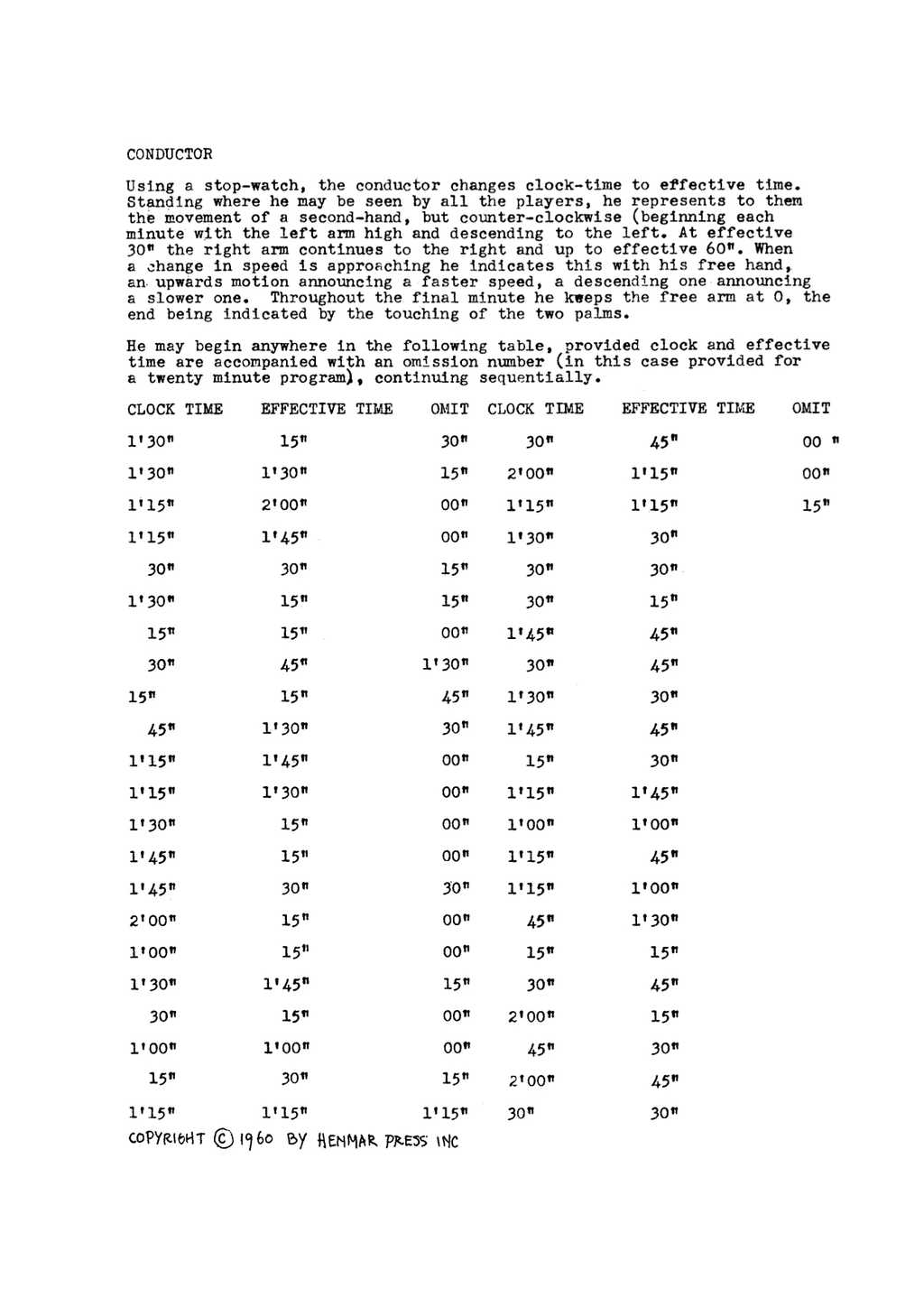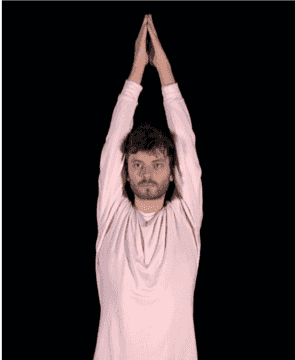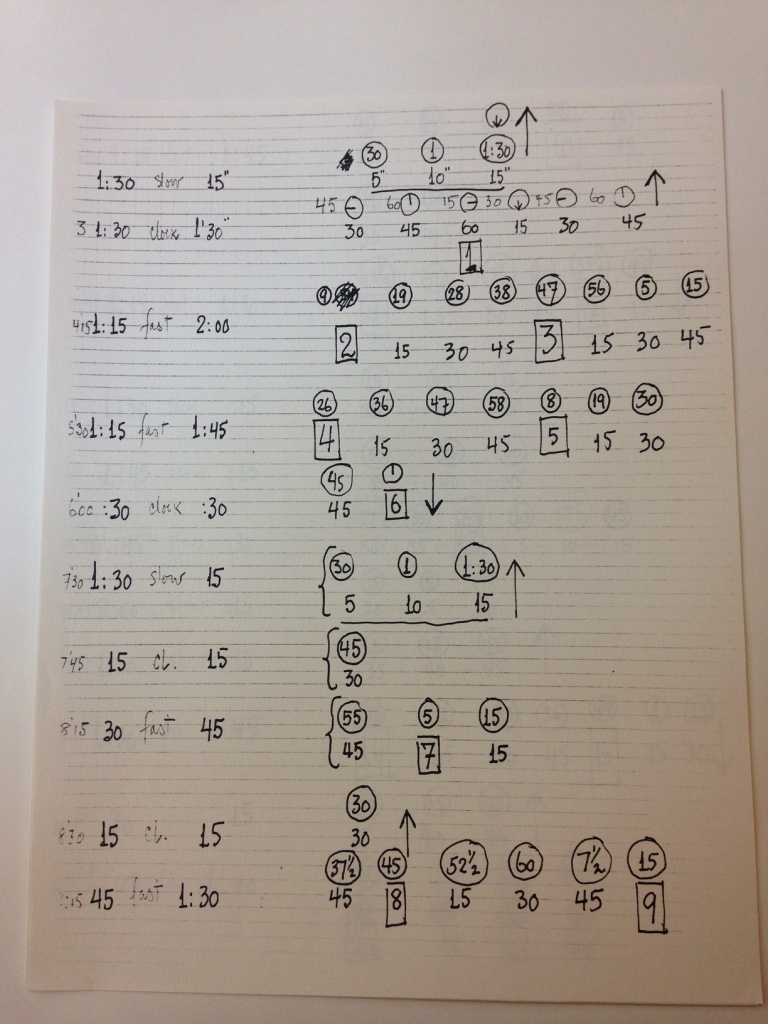The Conductor
Jack Sheen: Performing the conductor's part
John Cage, Concert for Piano and Orchestra, Conductor, column 2, rows 1–4
Jack Sheen
Introduction
Performances of the Concert for Piano and Orchestra, even for full ensemble, do not require a conductor—players can simply follow a stopwatch or some other means of measuring time. However, involving a conductor in a performance (which would be possible even if performed as a duo) makes for a very different and even more lively performance situation.
The conductor does not fulfil the usual role of an orchestral conductor, neither does she draw upon standard conducting technique. The conductor indicates time by representing a human clock, moving her arms anticlockwise (so that they appear to be moving in clockwise motion to the musicians), first left arm then, when the 6 o’clock position has been reached, changing to right arm to meet the left arm again at 12 o’clock. But the conductor is more than just a clock replacement, because this human clock changes the rate at which time passes. Thus the conductor moves variably her arms either slower or faster than normal clock time, or sometimes at the same speed as clock time.
However, to guard against the traditional use of conductor as interpreters, making the musicians respond to their interpretative will, Cage provides the conductor with a part to follow, which gives specific indications as to the sequence and rate of time changes. Cage often referred to the conductor as a ‘utility’ and specifically not as a ‘governing agent’. So the conductor’s actions are entirely independent of what the musicians do, and yet at the same time what the conductor does affect what they do.
The conductor's part

The conductor’s part consists of sequences of timings to convert clock time into what Cage calls ‘effective time’. The first page (pictured) is divided into two columns of timings, each with three columns. The left of these shows clock time and the central column shows how to convert that clock time into effective time. So the first row stipulates that 15 seconds of effective time should take 1′30″ of clock time, requiring the conductor to move her left arm very slowly indeed from the 12 o’clock position to the 9 o’clock position (moving anticlockwise), a rate of one-eighth normal speed. The second row requires the next 1′30″ of effective time (i.e. conductor time) to take exactly that amount of clock time, and the third row requires the next 2 minutes of effective time to take 1′15″ of clock time, meaning that each row is an acceleration of time from the previous. (While some of the conversions for moving slower than clock time reach to as much as an eighth of the speed of actual time, going faster never moves beyond twice as fast.) However, the conductor can start at any row from the part, and does not necessarily need to start from the beginning, so the actual sequence of timings may be quite different from one performance to another.
The third column is somewhat more confusing, requiring the conductor to omit a stated amount of time. However, this column need only be observed if the performance is for a 20-minute cycle, that is a performance that requires the conductor to make 20 rotations (which will of course last a duration other than 20 minutes due to the changing speeds). The reason for this is a practical one: if a performance of 20 cycles has been agreed then moving through the rows in sequence will mean eventually arriving at a timing which is, depending upon the row started from, either exactly twenty minutes of effective time or some duration longer than that. For example, if starting from the first row, then the closest to twenty minutes of effective time is the second row of the second column, which adds to 20′30″ of effective time. To convert this into a performance of exactly 20 conductor rotations, then, requires 30 seconds to be omitted. Hence at the first row, the ‘omit’ column states 30″. Likewise, if starting from the fourth row, the closest to twenty minutes of effective time is the seventh row of the second column, which arrives at exactly twenty minutes, hence at the fourth row which we started from the omit column states 00″. (The reason the omit timings stop at the third row of the second column is that if one were to start from any row beyond this then the total performance cannot last twenty rotations as there are insufficient rows for that to happen.) Cage does not stipulate from where one should omit the appropriate number of timings, and so if 30 seconds are required to be omitted this could be from, for example, the fifth row (effective time 30″) or could even be the sixth and seventh rows combined (each are 15″ of effective time). So the actual clock time of a performance depends not just on which row the conductor starts from but also upon which rows are omitted if any are required to be omitted.

But of course all this does not apply if the conductor has made a performance which is other shorter or longer than twenty minutes effective time (that is, a performance which is less or more than twenty arm rotations). Instead, one can take the broad principle that it is better to agree upon a duration of a whole number of rotations, so that, as Cage suggests, in the final minute the free arm can remain at the 12 o’clock position until the other arm joins it. (In subsequent performances Cage suggested that in the final 30 seconds both arms move from the 6 o’clock position to the 12 o’clock position. This makes it very clear to the players that the end is reached.) And therefore if the sequence of timings used ends with the arms at a position other than 12 o’clock then the appropriate number of seconds of effective time should be omitted from the sequence.
Making a realisation
The conductor has to plan a part, as rigorously as any of the instrumentalists, having first agreed the total duration available for the performance. (It is standard practice for the pianist to function independently, and not to follow the conductor’s movements, and so a total duration for the performance might need to be agreed with the pianist in advance. However, this need not be the case, with either the pianist working flexibly until the conductor stops moving, or the pianist may indeed follow the conductor’s movements along with the other instrumentalists.) Realisations of a conductor’s part in Cage’s hand housed in the John Cage Collection at the New York Public Library (pictured) show how the part might be planned, with numbers in squares indicating the number of rotations, actual clock time divisions of the minute in circles, accumulated clock time indications to the far left of the row, and arrows to the right indicating the change of speed moving to the next row.

The arrows might be used to indicate, using the hand which is not marking time, significant changes of speed to the orchestra, as suggested in the instructions to the part. Cage can be seen making such up and down motions in this footage of rehearsals with the second viola player and tuba players in Hans G. Helms’s film Birdcage – 73′20.958″ for a composer.
For the performance in Leeds, Sheen prepared a performance lasting 39 cycles, totalling 53 minutes. His realisation can be seen here. Each square represents a row from the part, and is divided into five second intervals, to work out the varying speeds throughout the piece.

The works of John Cage are the copyright of Henmar Press Inc., New York and are reproduced by permission of Peters Edition Limited, London. All rights reserved.
